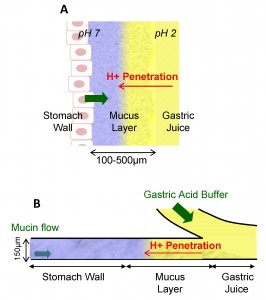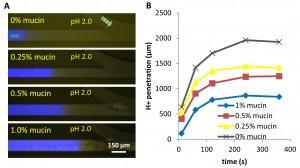Diffusive Transport of Acid through Mucus Hydrogels inside a Microfabricated Device
- Category: MEMS & BioMEMS
- Tags: jongyoon han, leon li
In the stomach, the biological hydrogel known as mucus protects the stomach wall from the damaging effects of strongly acidic digestive juices inside the stomach lumen. Altered mucus function is linked to gastric diseases including ulcers and cancers. The biophysical mechanisms underlying the barrier are not well understood, due partly to a lack of suitable in vitro tools.
In this work, we developed an in vitro microfluidic system designed to mimic mucus secretion in the stomach (see Figure 1) [1] . In our system, mucus components are pumped continuously on-chip into an acidic flow, mimicking in vivo mucus secretion into an acidic stomach lumen. A fluorescent pH indicator added to the samples allows optical tracking of acid diffusion. Our microfluidic system is superior to in vitro macroscale techniques currently used to assay mucus function [2] . Advantages of our system include study of barrier function under secretion rather than static conditions, ability to optically measure the pH profile inside the mucus layer, and low sample volume requirement enabling experiments using difficult-to-purify mucus components.
With this system, we demonstrate that continuous secretion of mucin glycoprotein, the dominant protein component of mucus, hinders the diffusion of acid (Figure 2) due to the ability of mucins to directly bind and sequester H+ (see [1] for more details). We further estimate that the barrier function resulting from direct binding of H+ to mucin constitutes a significant portion of the in vivo mucus barrier. This “mucus-secretion-on-a-chip” platform may be used to systematically study the barrier function of each mucus layer component, perform diagnostics of mucus function using small amounts of clinical sample, and test mucus-targeted drugs.
- Figure 1: A) A layer of gastric mucus provides an acid barrier for the epithelial cells of the stomach wall, protecting them from damage by acidic digestive juices. B) Microfluidic in vitro system to mimic the secretion of mucus in the stomach. The microfluidic system is used to study the mechanisms of the acid barrier.
- Figure 2: A) Fluorescent micrographs demonstrating acid penetration into the continuously secreted mucin layer in the microfluidic system. The false blue in each image derives from pH-sensitive Oregon Green (Invitrogen Inc.) dye added to samples to track acid diffusion. Oregon Green is fluorescent when pH >> 4.7 and non-fluorescent when pH << 4.7. Solid arrow: mucin flow. Hashed arrow: acid flow. B) Time response of acid penetration into mucus layer, showing higher concentration mucins are more effective at resisting acid penetration.
- D. L. Li, O. Lieleg, S. Jang, K. Ribbeck, and J. Han, “Microfludic in vitro system for quantitative study of stomach mucus barrier function,” Lab on a Chip, 2012, to be published. DOI: 10.1039/C2LC40161D. [↩] [↩]
- S. Tanaka, H. H. J. Meiselman, E. Engel, P. H. Guth, O. Furukawa, R. B. Wenby, J. Lee, J. D. Kaunitz, “Regional differences of H+, HCO3-, and CO2 diffusion through native porcine gastroduodenal mucus,” Dig. Dis. Sci., vol. 47, no. 5, pp. 967-973, May 2002. [↩]

